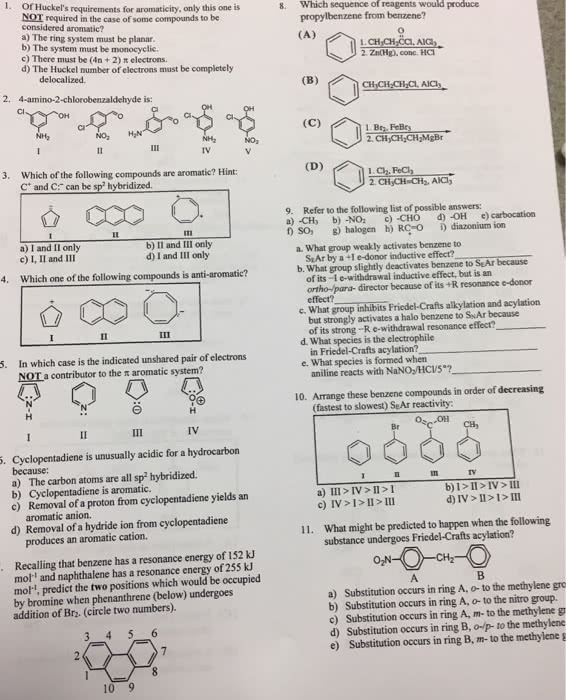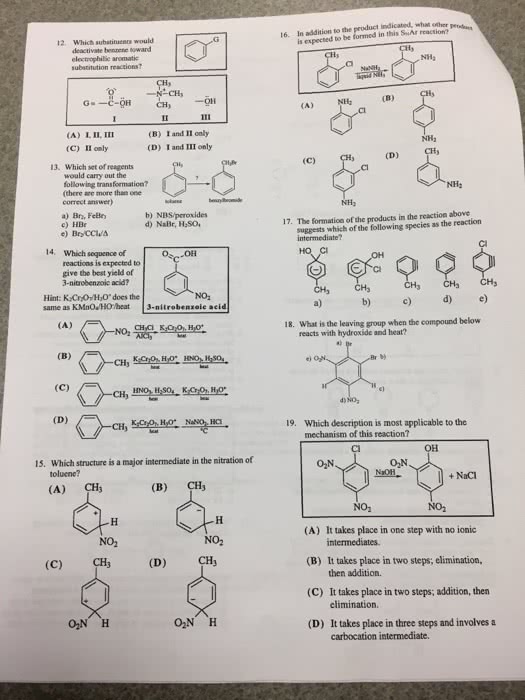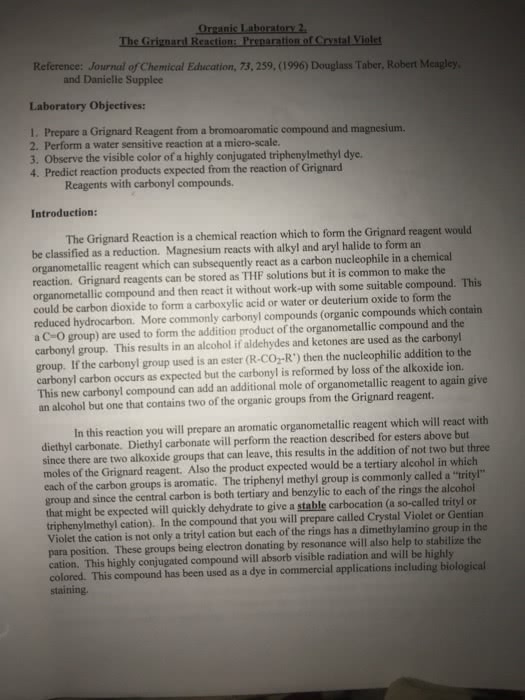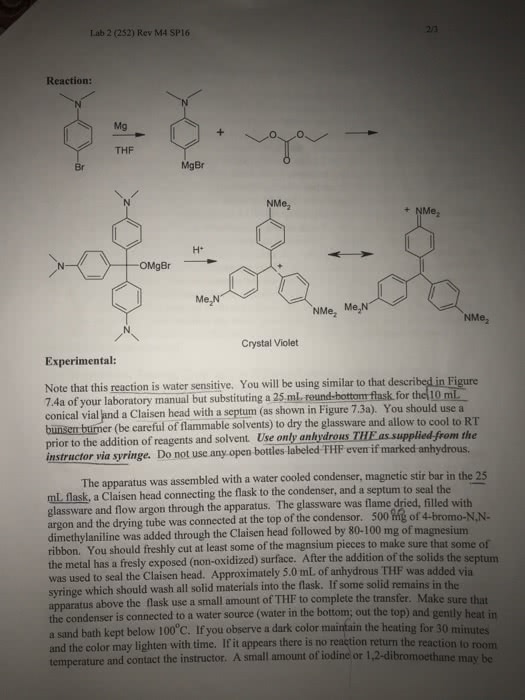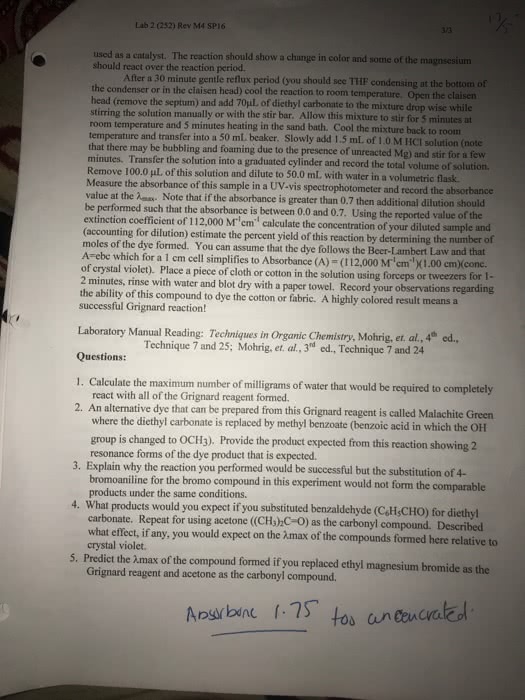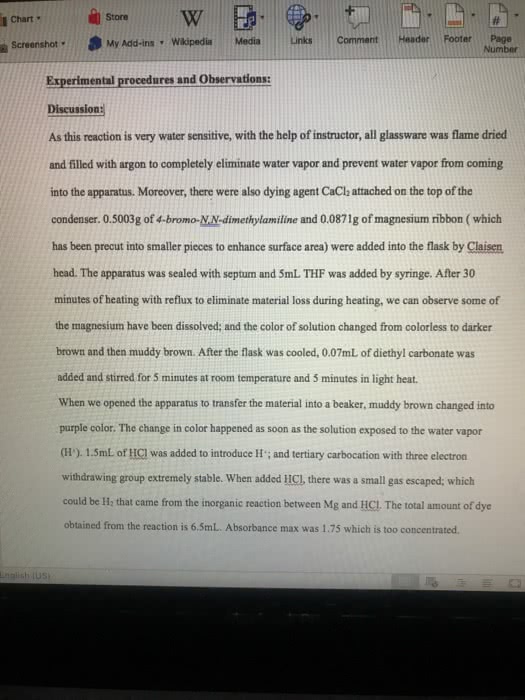1. Which of the following reagent(s) can be used to prepare a mixture of o and p-nitro toluene from toluene
(A) HNO2 (B) HNO3 (C) HNO3/Fe (D) HNO3/H2SO4 (E) NaNO2
2.
(A) H2SO3 (B) SO3/ Which of the following reagent(s) can be used to convert nitrobenzene to m-nitrobenzenesulfonic acid Fe (C) H2SO3/Fe (D) H2SO4/Al2(SO4)3 (E) H2SO4.SO3
3. Which of the following reagent(s) can be used to prepare bromobenzene from benzene
(A) NBS (B) Br2/FeBr3 (C) H2SO4/Br2 (D) Br2/AlBr3 (E) Br2/Pd
4. Which of the following functional groups are o,p-directing ?
(A) Br, CH2CH3, NH2 (B) Cl, NH2, COOH (C) I, SO3H, OH (D) OCH3, Cl, COCH3 (E) NO2, CH3, OH
5. Which of the following reagent(s) gives the reaction below
(A) CH3Cl (B) Cl2/ Fe (C) Cl2/ AlCl3 (D) Cl2/ FeCl3 (E) Cl2/ HCl
6. Friedal-Craft acylation reagent(s)
(A) CH3Cl/AlCl3 (B) Cl2/CH3COCl (C) CH3COCl/AlCl3 (D) CH3COCl/FeCl3 (E) CH3Cl/FeCl3
7. Which of the following functional groups are m-directing ?
(A) NO2, CH3, OH (B) Br, NH2, COOH (C) I, SO3H, OH (D) OCH3, Cl, COCH3 (E) COCH3, SO3H, CHO
8. Which of the following compound can be used in the Diels-Alder reaction
(A) 2-methyl, 2,4-hexadiene (B) 2,5-hexadiene (C) 1-methyl,cyclohexa-1,4-diene (D) cyclohexa-1,4-diene
(E) 2-methyl, 1,5-hexadiene
9. Which statement about benzene is incorrect?
(A) The C�C p - bonding is delocalized (B) The C6 ring is planar (C) The average C - C bond distance is the same as C-C double bonds (D) Each C atom is sp2 hybridized ( E ) There are 12 s (sigma) bonds in benzene
10. Which of the following is NOT aromatic
(A) Cyclopropenyl cation (C3H3+) (B) Benzene (C6H6) (C) [16]-Annulene (C16H16)
(D) Cycloheptatrienyl cation (C7H7+) (E) [18]-Annulene (C18H18)
11. Conjugate addition of one equivalent of deuterium bromide (DBr) to 1,3-butadiene gives
(A) 3-bromo, 4-deutero, 1-butene (B) 3-bromo, 4-deutero, 2-butene (C) 4-bromo, 3-deutero, 1-butene (D) 1-bromo, 4-deutero, 2-butene (E) 1-bromo, 4-deutero, 1-butene
12. Which of the following is a conjugated diene
(A) cyclopentadiene (B) 2-methylcyclohexanone (C) 1-methyl,cyclohexa-1,4-diene (D) cyclohexa-1,4-diene
(E) cycloocta-1,5-diene
13. The aromatic compound is
14. Which of the following reaction involves a benzyne mechanism ?
(A) Ph-CH3 ? Ph-COOH (B) Ph-CH3 ? Ph-CHO (C) Ph-OH ? Ph-Cl (D) Ph-Cl ? Ph-OH
(E) none of these
15. Which of the following reagent(s) can be used to prepare a mixture of o and p-nitro toluene from
toluene
(A) HNO2 (B) HNO3 (C) HNO3/Fe (D) HNO3/H2SO4 (E) NaNO2
16. Friedal-Craft alkyation reagent(s)
(A) C2H5Cl/AlCl3 (B) Cl2/CH3COCl (C) CH3COCl/AlCl3 (D) CH3COCl/FeCl3 (E) CH3Cl/FeCl3
17. Which of the following functional groups are o,p-directing ?
(A) NO2, SO3H, CHO (B) Br, NH2, COOH (C) I, OH, CH3 (D) OCH3, Cl, COCH3 (E) COCH3, SO3H, Br
18. Major product in the reaction of benzene with 1-bromopropane, in the presence of AlBr3 catalyst
(A) bromobenzene (B) n-propylbenzene (C) iso-propylbenzene (D) o-bromo-n-propylbenzene
(E) p-bromo-n-propylbenzene
19. Which of the following is the electrophile in the nitration reaction
(A) +HNO2 (B) NO2+ (C) N2+ (D) HNO3/H2SO4 (E) NO3+
20. Which of the following is the electrophile in the sulfonation reaction
(A) +HSO2 (B) SO2+ (C) SO3+ (D) SO3/H2SO4 (E) HSO3+
21. Which of the following is the electrophile in the Friedel-Craft acylation reaction
(A) RCO2+ (B) RCO+ (C) CO2+ (D) RX/H2SO4 (E) RCO3+
22. The benzyne intermediate has �� p bonds
(A) 1 (B) 2 (C) 3 (D) 4 (E) 5
23. The reagent used for Allylic/benzylic bromination is:
(A) NBS (B) Br2/ Fe (C) Br2/ AlBr3 (D) Br2/ FeBr3 (E) Br2/ HBr
24. Which of the following is an oxidation reagent
(A) H2SO4 (B) KMnO4 (C) KMnO2 (D) NaBH4 (E) AlCl3
25. The formula of fuming sulfuric acid
(A) H2SO4.SO3 (B) H2SO4.SO2 (C) H2SO4.HSO2 (D) H2SO4.HSO3 (E) H2SO4.SO
��������������������������������������������
26. How do you prepare the following compounds, starting from benzene ?
(a). aniline (b). Iodo benzene (c). benzoic acid (d). benzylbromide (e). m-methyl benzoic acid
(f). p-nitrobenzoic acid (g) m-nitrobenzoic acid (h). p-chlorobenzenesulfonic acid (i). m-chlorobenzenesulfonic
acid (j) 3-isopropyl benzoic acid (k). 4-isopropyl toluene
27. Draw the product(s) from the following reactions showing the mechanisms
(a) 1,3-butadiene with acrylonitrile
(b) 1,3-butadiene with one eqv. HBr
(c) 1,3-cyclohexadiene with acrylonitrile
(d) 1,3-cyclohexadiene with one eqv. HBr
(e) 1,3-cyclohexadiene with two eqv. HBr
(f) cyclopentadiene with two eqv. HBr
28. How do you prepare the following compounds, starting from toluene ?
(a). benzoic acid (b). benzyl alcohol (c). m-bromobenzoic acid (d). m-methylbenzoic acid (e). m-nitro
benzoic acid (f). p-nitrobenzoic acid
29. What is/are the product(s) expected when ethylbenzene is reacted with
(a). NBS
(b). Br2/FeBr3
(c). KMnO4, then H+
(d). fuming H2SO4
(e). NBS, then aq. NaOH
(f) iso-butylbromide/AlBr3


